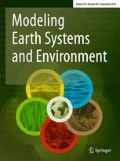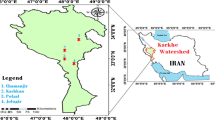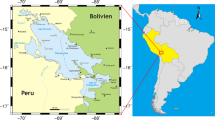Abstract
An accurate water quality index (WQI) forecast is essential for freshwater resources management due to providing early warnings to prevent environmental disasters. This research provides a novel procedure to simulate monthly WQI considering water quality parameters and rainfall. The methodology includes data pre-processing and an artificial neural network (ANN) model integrated with the constraint coefficient-based particle swarm optimization and chaotic gravitational search algorithm (CPSOCGSA). The CPSOCGSA technique was compared with the marine predator's optimization algorithm (MPA) and particle swarm optimization (PSO) to increase the model's reliability. The Yesilirmak River data from 1995 to 2014 was considered to build and inspect the suggested strategy. The outcomes show the pre-processing data methods enhance the quality of the original dataset and identify the optimal predictors' scenario. The CPSOCGSA-ANN algorithm delivers the best performance compared with MPA-ANN and PSO-ANN considering multiple statistical indicators. Overall, the methodology shows good performance with R2 = 0.965, MAE = 0.01627, and RMSE = 0.0187.






Similar content being viewed by others
References
Abd Elaziz M, Shehabeldeen TA, Elsheikh AH, Zhou J, Ewees AA, Al-qaness MAA (2020) Utilization of random vector functional link integrated with marine predators algorithm for tensile behavior prediction of dissimilar friction stir welded aluminum alloy joints. J Market Res 9(5):11370–11381. https://doi.org/10.1016/j.jmrt.2020.08.022
Aghel B, Rezaei A, Mohadesi M (2018) Modeling and prediction of water quality parameters using a hybrid particle swarm optimization-neural fuzzy approach. Int J Environ Sci Technol 16(8):4823–4832. https://doi.org/10.1007/s13762-018-1896-3
Ahmed MS, Mohamed A, Khatib T, Shareef H, Homod RZ, Ali JA (2017) Real time optimal schedule controller for home energy management system using new binary backtracking search algorithm. Energy Build 138:215–227. https://doi.org/10.1016/j.enbuild.2016.12.052
Alawsi MA, Zubaidi SL, Al-Ansari N, Al-Bugharbee H, Ridha HM (2022) Tuning ann hyperparameters by CPSOCGSA, MPA, and SMA for short-term spi drought forecasting. Atmosphere 13(9):1436
Aldhyani TH, Al-Yaari M, Alkahtani H, Maashi M (2020a) Water quality prediction using artificial intelligence algorithms. Appl Bionics Biomech
Aldhyani THH, Al-Yaari M, Alkahtani H, Maashi M (2020b) Water quality prediction using artificial intelligence algorithms. Appl Bionics Biomech 2020:6659314. https://doi.org/10.1155/2020/6659314
Araghinejad S (2013) Data-driven modeling: using Matlab® in water resources and environmental engineering, vol 67. Springer
Asadollah SBHS, Sharafati A, Motta D, Yaseen ZM (2021) River water quality index prediction and uncertainty analysis: a comparative study of machine learning models. J Environ Chem Eng. https://doi.org/10.1016/j.jece.2020.104599
Azad A, Karami H, Farzin S, Mousavi S-F, Kisi O (2019) Modeling river water quality parameters using modified adaptive neuro fuzzy inference system. Water Sci Eng 12(1):45–54. https://doi.org/10.1016/j.wse.2018.11.001
Calì D, Osterhage T, Streblow R, Müller D (2016) Energy performance gap in refurbished german dwellings: lesson learned from a field test. Energy Build 127:1146–1158
Chang F-J, Chen P-A, Chang L-C, Tsai Y-H (2016) Estimating spatio-temporal dynamics of stream total phosphate concentration by soft computing techniques. Sci Total Environ 562:228–236
Chen Y, Song L, Liu Y, Yang L, Li D (2020) A review of the artificial neural network models for water quality prediction. Appl Sci 10(17):5776
Das Kangabam R, Bhoominathan SD, Kanagaraj S, Govindaraju M (2017) Development of a water quality index (WQI) for the loktak lake in india. Appl Water Sci 7(6):2907–2918
Dawson CW, Abrahart RJ, See LM (2007) Hydrotest: a web-based toolbox of evaluation metrics for the standardised assessment of hydrological forecasts. Environ Model Softw 22(7):1034–1052
Dinc B, Çelebi A, Avaz G, Canlı O, Güzel B, Eren B, Yetis U (2021) Spatial distribution and source identification of persistent organic pollutants in the sediments of the yeşilırmak river and coastal area in the black sea. Mar Pollut Bull 172:112884
Ewaid SH, Abed SA, Kadhum SA (2018) Predicting the tigris river water quality within Baghdad, Iraq by using water quality index and regression analysis. Environ Technol Innov 11:390–398
Faramarzi A, Heidarinejad M, Mirjalili S, Gandomi AH (2020) Marine predators algorithm: a nature-inspired metaheuristic. Expert Syst Appl 152:113377
Faruk DÖ (2010) A hybrid neural network and arima model for water quality time series prediction. Eng Appl Artif Intell 23(4):586–594
Gharghan SK, Nordin R, Ismail M (2016) A wireless sensor network with soft computing localization techniques for track cycling applications. Sensors 16(8):1043
Ghorbani MA, Deo RC, Karimi V, Yaseen ZM, Terzi O (2018) Implementation of a hybrid MLP-FFA model for water level prediction of lake Egirdir, Turkey. Stoch Env Res Risk Assess 32(6):1683–1697
Golyandina N, Korobeynikov A, Zhigljavsky A (2018) Singular spectrum analysis with r. Springer, New York
Gupta S, Gupta SK (2021) A critical review on water quality index tool: genesis, evolution and future directions. Ecol Inform. https://doi.org/10.1016/j.ecoinf.2021.101299
Hajirahimi Z, Khashei M (2022) Hybridization of hybrid structures for time series forecasting: a review. Artif Intell Rev. https://doi.org/10.1007/s10462-022-10199-0
Hameed M, Sharqi SS, Yaseen ZM, Afan HA, Hussain A, Elshafie A (2016) Application of artificial intelligence (AI) techniques in water quality index prediction: a case study in tropical region, malaysia. Neural Comput Appl 28(S1):893–905. https://doi.org/10.1007/s00521-016-2404-7
Huo S, He Z, Su J, Xi B, Zhu C (2013) Using artificial neural network models for eutrophication prediction. Proc Environ Sci 18:310–316
Judran NH, Kumar A (2020) Evaluation of water quality of Al-Gharraf river using the water quality index (WQI). Model Earth Syst Environ 6(3):1581–1588. https://doi.org/10.1007/s40808-020-00775-0
Kadam A, Wagh V, Muley A, Umrikar B, Sankhua R (2019) Prediction of water quality index using artificial neural network and multiple linear regression modelling approach in Shivganga river basin, India. Model Earth Syst Environ 5(3):951–962
Karami F, Dariane AB (2022) Melody search algorithm using online evolving artificial neural network coupled with singular spectrum analysis for multireservoir system management. Iran J Sci Technol Trans Civ Eng 46(2):1445–1457
Koranga M, Pant P, Kumar T, Pant D, Bhatt AK, Pant R (2022) Efficient water quality prediction models based on machine learning algorithms for Nainital Lake, Uttarakhand. In: Materials today: proceedings
Kossieris P, Makropoulos C (2018) Exploring the statistical and distributional properties of residential water demand at fine time scales. Water 10(10):1481
Kouadri S, Pande CB, Panneerselvam B, Moharir KN, Elbeltagi A (2022) Prediction of irrigation groundwater quality parameters using ANN, LSTM, and MLR models. Environ Sci Pollut Res 29(14):21067–21091
Kulisz M, Kujawska J, Przysucha B, Cel W (2021) Forecasting water quality index in groundwater using artificial neural network. Energies 14(18):5875
Kulisz M, Kujawska J (2021) Application of artificial neural network (ANN) for water quality index (WQI) prediction for the River Warta, Poland. In: Paper presented at the Journal of Physics: conference series
Michalak AM (2016) Study role of climate change in extreme threats to water quality. Nature 535(7612):349–350. https://doi.org/10.1038/535349a
Modaresi F, Araghinejad S (2014) A comparative assessment of support vector machines, probabilistic neural networks, and k-nearest neighbor algorithms for water quality classification. Water Resour Manag 28(12):4095–4111
Mohammadi B, Mehdizadeh S (2020) Modeling daily reference evapotranspiration via a novel approach based on support vector regression coupled with whale optimization algorithm. Agricult Water Manag 237:106145. https://doi.org/10.1016/j.agwat.2020.106145
Mohammadi B, Linh NTT, Pham QB, Ahmed AN, Vojteková J, Guan Y, Abba SI, El-Shafie A (2020) Adaptive neuro-fuzzy inference system coupled with shuffled frog leaping algorithm for predicting river streamflow time series. Hydrol Sci J 65(10):1738–1751. https://doi.org/10.1080/02626667.2020.1758703
Nabipour N, Dehghani M, Mosavi A, Shamshirband S (2020) Short-term hydrological drought forecasting based on different nature-inspired optimization algorithms hybridized with artificial neural networks. IEEE Access 8:15210–15222. https://doi.org/10.1109/access.2020.2964584
NOAA (2021) National oceanic and atmospheric administration. Data tools: find a station. https://www.ncdc.noaa.gov/cdo-web/datatools/findstation
Ouyang Q, Lu W (2018) Monthly rainfall forecasting using echo state networks coupled with data preprocessing methods. Water Resour Manag 32(2):659–674
Pallant J (2020) SPSS survival manual: a step by step guide to data analysis using ibm. SPSS, Routledge
Panaskar D, Wagh V, Muley A, Mukate S, Pawar R, Aamalawar M (2016) Evaluating groundwater suitability for the domestic, irrigation, and industrial purposes in Nanded Tehsil, Maharashtra, India, using GIS and statistics. Arab J Geosci 9(13):1–16
Payal A, Rai CS, Reddy BR (2015) Analysis of some feedforward artificial neural network training algorithms for developing localization framework in wireless sensor networks. Wirel Pers Commun 82(4):2519–2536
Pham QB, Yang T-C, Kuo C-M, Tseng H-W, Yu P-S (2021) Coupling singular spectrum analysis with least square support vector machine to improve accuracy of SPI drought forecasting. Water Resour Manag 35(3):847–868
Polomčić D, Gligorić Z, Bajić D, Cvijović Č (2017) A hybrid model for forecasting groundwater levels based on fuzzy c-mean clustering and singular spectrum analysis. Water 9(7):541
Rajaee T, Boroumand A (2015) Forecasting of chlorophyll-a concentrations in south san francisco bay using five different models. Appl Ocean Res 53:208–217
Ramakrishnaiah C, Sadashivaiah C, Ranganna G (2009) Assessment of water quality index for the groundwater in Tumkur Taluk, Karnataka State, India. E-J. Chem. 6(2):523–530
Rather SA, Bala PS (2019a) Hybridization of constriction coefficient-based particle swarm optimization and chaotic gravitational search algorithm for solving engineering design problems. In: Paper presented at the international conference on advanced communication and networking
Rather SA, Bala PS (2019b) Hybridization of constriction coefficient based particle swarm optimization and gravitational search algorithm for function optimization. In: Paper presented at the proceedings of the international conference on advances in electronics, electrical & computational intelligence (ICAEEC)
Reddy PCS, Yadala S, Goddumarri SN (2022) Development of rainfall forecasting model using machine learning with singular spectrum analysis. IIUM Eng J 23(1):172–186
Sakizadeh M (2016) Artificial intelligence for the prediction of water quality index in groundwater systems. Model Earth Syst Environ 2(1):1–9
Şener Ş, Şener E, Davraz A (2017) Evaluation of water quality using water quality index (WQI) method and GIS in Aksu River (SW-Turkey). Sci Total Environ 584:131–144
Shanley K (2017) Climate change and water quality: keeping a finger on the pulse. Am J Public Health 107(1):e10. https://doi.org/10.2105/ajph.2016.303504
Sharma P, Meher PK, Kumar A, Gautam YP, Mishra KP (2014) Changes in water quality index of ganges river at different locations in allahabad. Sustain Water Qual Ecol 3:67–76
Tabachnick BG, Fidell LS, Ullman JB (2007) Using multivariate statistics, vol 5. Pearson, Boston
Tao H, Al-Bedyry NK, Khedher KM, Shahid S, Yaseen ZM (2021) River water level prediction in coastal catchment using hybridized relevance vector machine model with improved grasshopper optimization. J Hydrol 598:126477
Taylor KE (2001) Summarizing multiple aspects of model performance in a single diagram. J Geophys Res Atmos 106(D7):7183–7192. https://doi.org/10.1029/2000jd900719
Uddin MG, Nash S, Olbert AI (2021) A review of water quality index models and their use for assessing surface water quality. Ecol Ind 122:107218
Ustaoğlu F, Tepe Y, Taş B (2020) Assessment of stream quality and health risk in a subtropical turkey river system: a combined approach using statistical analysis and water quality index. Ecol Indic. https://doi.org/10.1016/j.ecolind.2019.105815
Valentini M, dos Santos GB, Muller Vieira B (2021) Multiple linear regression analysis (MLR) applied for modeling a new WQI equation for monitoring the water quality of Mirim Lagoon, in the State of Rio Grande do Sul—Brazil. SN Appl Sci 3(1):70. https://doi.org/10.1007/s42452-020-04005-1
Vijay S, Kamaraj K (2021) Prediction of water quality index in drinking water distribution system using activation functions based ann. Water Resour Manag 35(2):535–553
WH Organization, WHO, Staff WHO (2004) Guidelines for drinking-water quality, vol 1. World Health Organization
Wu J, Wang Z (2022) A hybrid model for water quality prediction based on an artificial neural network, wavelet transform, and long short-term memory. Water 14(4):610
Yilma M, Kiflie Z, Windsperger A, Gessese N (2018) Application of artificial neural network in water quality index prediction: a case study in little akaki river, addis ababa, ethiopia. Model Earth Syst Environ 4(1):175–187
Yousri D, Babu TS, Beshr E, Eteiba MB, Allam D (2020) A robust strategy based on marine predators algorithm for large scale photovoltaic array reconfiguration to mitigate the partial shading effect on the performance of pv system. IEEE Access 8:112407–112426. https://doi.org/10.1109/access.2020.3000420
Zubaidi SL, Gharghan SK, Dooley J, Alkhaddar RM, Abdellatif M (2018) Short-term urban water demand prediction considering weather factors. Water Resour Manag 32(14):4527–4542. https://doi.org/10.1007/s11269-018-2061-y
Author information
Authors and Affiliations
Corresponding author
Ethics declarations
Conflict of interest
The authors declare that they have no personal or financial interest, which could influence the work presented in this paper.
Additional information
Publisher's Note
Springer Nature remains neutral with regard to jurisdictional claims in published maps and institutional affiliations.
Rights and permissions
Springer Nature or its licensor (e.g. a society or other partner) holds exclusive rights to this article under a publishing agreement with the author(s) or other rightsholder(s); author self-archiving of the accepted manuscript version of this article is solely governed by the terms of such publishing agreement and applicable law.
About this article
Cite this article
Zamili, H., Bakan, G., Zubaidi, S.L. et al. Water quality index forecast using artificial neural network techniques optimized with different metaheuristic algorithms. Model. Earth Syst. Environ. 9, 4323–4333 (2023). https://doi.org/10.1007/s40808-023-01750-1
Received:
Accepted:
Published:
Issue Date:
DOI: https://doi.org/10.1007/s40808-023-01750-1




